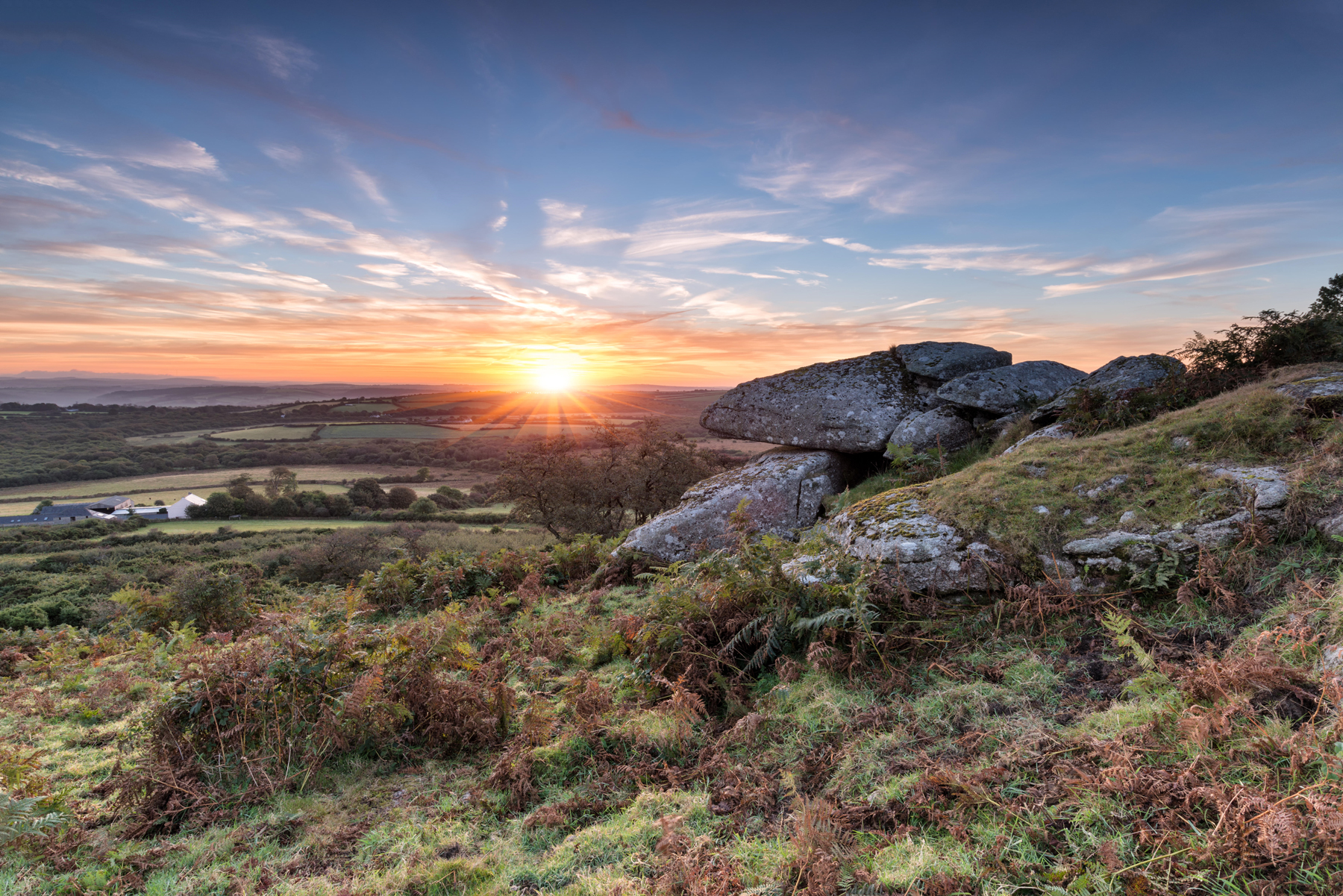Benedict Macdonald writes on our two Cornwall projects
Rewilding. It’s a buzzword. But could keystone species that once shaped Britain – from beavers to boar to bison – be the key to tackling the nature and climate crises? Award-winning television producer, nature writer and conservationist, Benedict Macdonald, details the benefits it could bring to both biodiversity and people, starting with our plans to rewild Helman Tor.
The moors of Cornwall would once have been places of unimaginable complexity and chaotic beauty. Across its uplands, beaver-crafted swamps of willow and oak would have given way to areas naturally too wet for trees to grow, alive with cranes and crakes. Wild cattle, aurochs, would, in far lower densities than we associate cattle today, have browsed and grazed these landscapes alongside the wild horses ideally adapted to the harshest of our upland winters. The Cornish wind – one force of nature that has not relinquished its grip on this landscape – would have bent entire forests growing far higher than we find them today, due to historical deforestation for grazing. Boar would have rootled and created life for new plants to thrive, unwittingly digging amphibian ponds with giant snouts. It would have been a wonderful place.
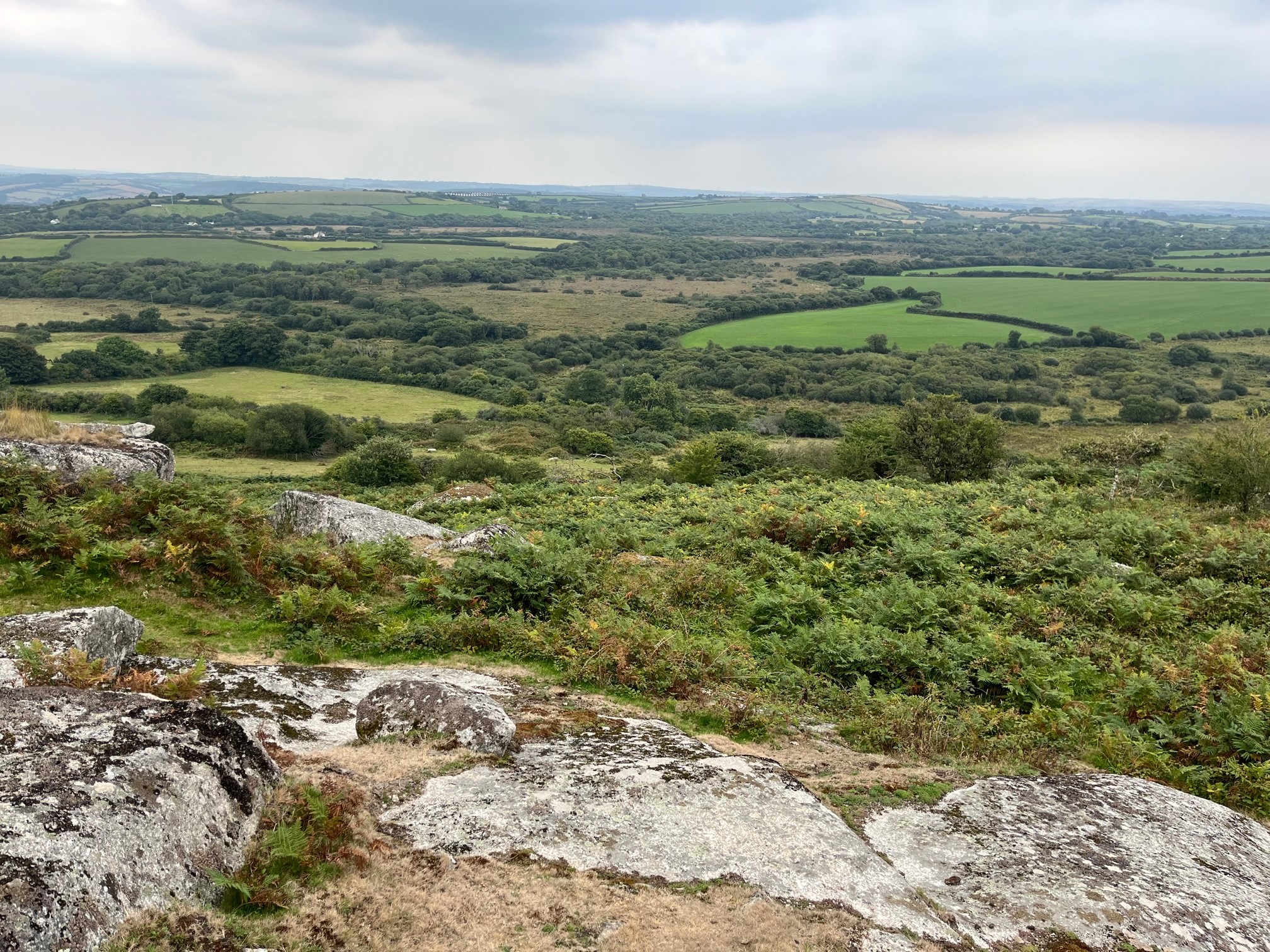
View looking south from Helman Tor. Newly bought Creney farm in background c JM
Over time, all but fragments of this world have disappeared from Cornwall. And yet, it is my view that extraordinary acts of nature restoration can, and will, happen in this landscape in the years to come. I know because they are already beginning. And a few have already begun.
In the past two years, having worked as a lifelong television producer and writer, I became a little more involved in this journey myself when I decided the time had come to start driving forwards the urgent need to restore nature at scale here in the UK – on the front line. Now working as Head of Nature Restoration at Real Wild Estates, a company specialising in restoring nature at scale for landowners, NGOs and communities, I get out of bed each morning wondering whether it’s going to be a day of ordering beavers, acquiring a new landscape to return to nature, or calculating the yields a farmer could make from allowing more nature to sequester carbon on his land. It’s been a truly exciting journey.
Hamatethy Farm
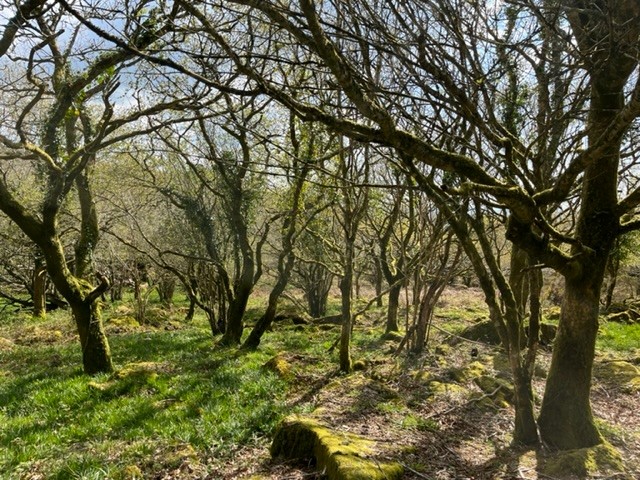
Hamatethys old intact Atlantic Rainforest C Julian Matthews
Last May, we were extremely fortunate to begin our work in Cornwall as we help Hamatethy Farm – a nature restoration project run by Yam and Camilla Swiderski and their stockman/farmer, Robert – on Bodmin Moor. In just a short period of time, the amount of life that is returning to the land is inspirational, even though the farm continues to produce high-quality, organic meat. Beaver ponds are now alive with amphibians, whilst otters and kingfishers more regularly visit these complex, ever-changing worlds of light, fallen wood and new coppiced vegetation. Low-intensity, worm-free cattle move across the whole landscape largely unhindered, and their dung is once again recruiting dung beetles.
Cuckoos have, contrary to the national trend, moved back from the very margins of the site to what were historically overgrazed fields. We have begun planting small treebanks, to reseed the open areas with willow, hawthorn, blackthorn, spindle, birch, rowan and yew, gently reversing centuries of woodland being on the back foot. In marshier areas we have sought to keep more water, not less, on the land, in the hope of attracting back wading birds.
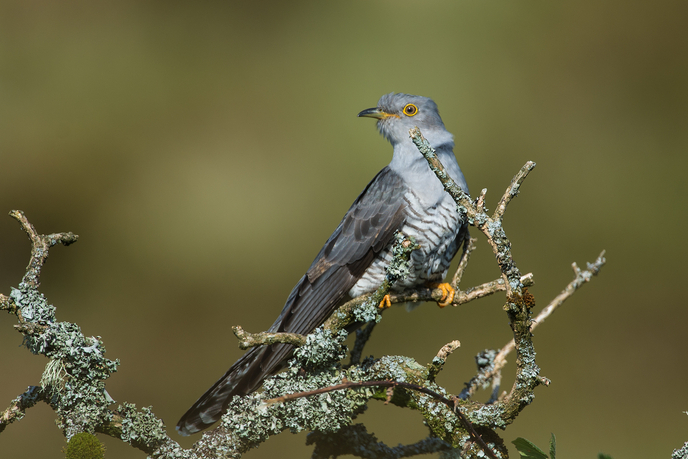
Cuckoo in Cornwall, Image by Adrian Langdon
For me, however, nothing compares to the excitement of a new arrival at Hamatethy last autumn: Cornish black pigs. One of the greatest missing components in most of Britain is the rotavating role once played by wild boar. These friendly farmland ‘boar’, however, can serve many of the same functions. One of the greatest problems we faced at Hamatethy was how we were going to reverse soil compaction and the simplified field structure to create something more exciting and complex for nature. Enter the pigs.
Tasked with ‘rootling’, the pigs got to work unearthing food within the soil with a great amount of enthusiasm matched only by ecological skill. They took ecological sameness of once-sheep grazed fields and rapidly turned it back to variety, exposing open soils that, this spring, will be colonised by wildflowers and new grasses. But the great thing about nature restoration, in place of conventional conservation, is the element of surprise. Who would have thought that a whole flock of starlings would, almost immediately, begin following the pigs around?
Starlings are a red-listed species, critically declining in their millions, even if still common in some areas. We are always told they need ‘permanent pasture’ but really, it’s the food within that pasture they require. And now, the pigs had opened the best restaurant in town for the starlings. You won’t read about this in books because starlings don’t read the books that we write.
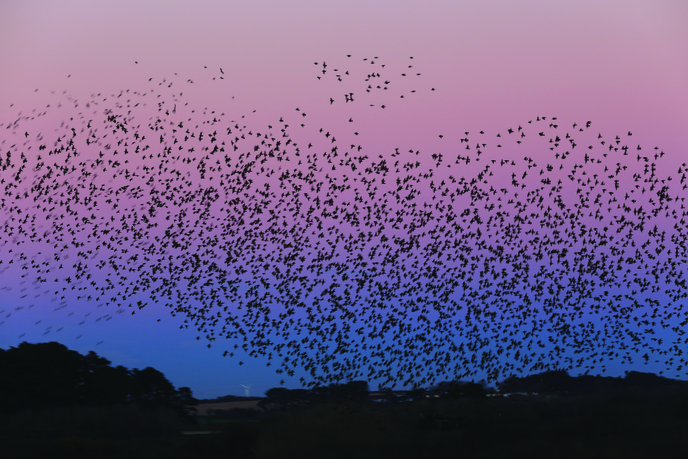
Starlings at Marazion by Tony Mills
The great joy of ambitious nature restoration that is process-led (popularly referred to as ‘rewilding’), is that if you give nature more options, it’s amazing to see how it thrives. Suppose we had tried to ‘manage’ Hamatethy with its inspiring landowners as a conventional farm for birds, we would have put in little cuckoo strips, starling paddocks or other zoo-gardening techniques aimed at a single red-listed species. Inevitably, these schemes would then have come into conflict with other action plans for other red-listed species. By resetting the entire system, however, we are already seeing increases in red-listed species across the board.
Take the spotted flycatcher. Declining drastically due to the lack of abundant flying insects in wood-studded habitats across the UK. A single pair of flycatchers will need to take approximately 90,000 insects to survive a summer here in the UK. My book, Rebirding, examines this in more detail, as well as the diets of cuckoos and many other species. This summer, flycatchers thrived across Hamatethy, inhabiting new territories and raising successful broods. The secret? Get the system right and the insects and structural diversity return. Get that right, and the flycatchers do absolutely fine. We have also seen huge increases in the autumn gatherings of house martins and swallows over Hamatethy, as the land literally pumps out avian aerial food into the sky. It’s been an amazing beginning.
Over the next fifteen years, we hope to continue this journey. Landowners are a critical part of this journey, but so are local farmers and stockman. I have been endlessly impressed within the innovation of Robert, Hamatethy’s stockman, who now looks after cattle, pigs and beavers, as well as helping us to put scrub-banks back into fields. Occasionally bemused by my ‘rewilding’ techniques, he brings the vital local knowledge, animal husbandry and farming nous to make this project sing – and is incredibly proud of his Welsh blacks.
But if this is rewilding, so to speak, then surely, Robert is not a farmer? Quite the opposite. We are still farming at Hamatethy, but at a density the land and its nature can sustain. Premium organic beef, unlike beef filled with growth hormones or chemicals, comes off the land and into the human food chain, replete with a whole range of vital minerals and proteins. The best term for what we are doing, then, would be ‘wilder farming’. Terms can be misleading. I can have the same conversation with the same person about ‘wilder farming’ and ‘rewilding’ – and have a very different reaction. It’s possible the word, itself, has become unhelpful.
Hamatethy has been an incredible first project for my organisation, Real Wild Estates, to have been a small part of getting off the ground. But things got more exciting when we partnered with our first NGO –Cornwall Wildlife Trust – to help further restore the wildlife, ecosystem functionality and ‘wildness’ of the Trust’s Helman Tor nature reserve near Lostwithiel.
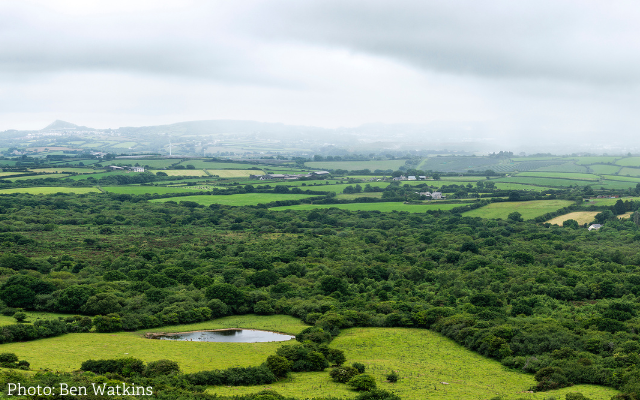
Ben Watkins
Helman Tor
Helman Tor is a very different proposal to Hamatethy. In some ways, it has done a remarkable job of reverting itself to nature, as dense birch and willow has grown back across much of the site. But trees are not supposed to grow uncontested. As I explain in my book Rebirding – as does Isabella Tree in her wonderful book Wilding – wild herbivores (cattle, horses, beavers, deer and historically, elk) are a critical missing component of such a place. And that is why we hope to put some of these ecosystem architects back.
Working closely with the fantastic team at Cornwall Wildlife Trust, we hope to restore wild beavers to a landscape absolutely suited to their needs. It always makes me chuckle when people talk about beaver ‘habitat’, because beavers create, define, shape and remake habitats for a profession. They do, however, require, or at least prefer, large quantities of willow and birch, although we have found the Hamatethy ones to be fond of rhododendron. So, beavers at Helman Tor are an exciting prospect indeed.
Many other countries, such as the Netherlands, are now powering ahead with their rewilding efforts, restoring bison to sand dunes and living happily alongside farmland wolves. In Britain, we are still very much behind the curve. Whilst a lot of criticism is often levelled at farmers and landowners, in my view, paperwork and statutory bodies are amongst the greatest problems we face in trying to innovate new landscapes back to life. It is still far, far easier to wipe out a population of turtle doves with herbicide, build on a brownfield site or get permission to release 60 million pheasants per year than to get permission to return a family of beavers into a large nature reserve without a ridiculous fence around the edge. The pace of change is glacial and often many statutes designed in the 1980s, though well-meant at the time, were written by those who did not truly understand ecosystems, their dynamism, the chaotic wonder of scrub – or indeed how nature truly works.
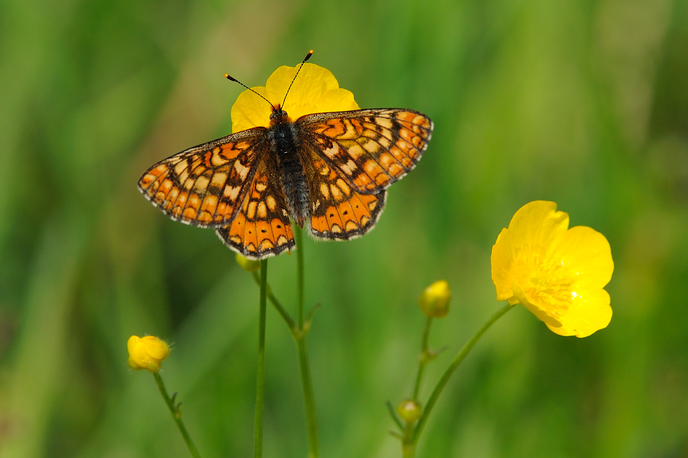
Marsh Fritillary Butterfly, Image by Amy Lewis
Helman Tor is a SSSI (Site of Special Scientific Interest), and rightly so. It has good legal protection as a result, and protects many important species, such as threatened marsh fritillary butterflies. But such designations can also be intensely problematic. They can often treat the countryside like a zoo, where each species is told what it needs, and the landscape treated more like a museum than a dynamic, changing entity, where animals like beavers and cattle can be given more of a role as ecosystem architects. It will be a challenge, though one we are excited about, to ensure that restoring Helman Tor to its full glory is driven by ecosystem understanding coupled with brilliant local work on the ground – not centralised paperwork designed four decades ago. But this is all a part of my job!
One of the fantastic things about The Wildlife Trusts, and there are many, is their localised approach. Helman Tor already has an ecology team, and all my organisation, Real Wild Estates, are adding to that team is an ecosystem vision of how to further restore nature, increase naturalness, climate resilience and develop a system that no longer needs to be so heavily managed by humans. Nature managed quite well before we went around cutting scrub – and beavers are really very good at it, given a chance. The team are excited about this process of still managing the site, but, as they see it, managing the four-legged, furrier managers working on their behalf!
It is very exciting time in nature restoration right now. Across the UK, landowners and farmers, not just NGOs, are driving for far more ambitious changes than many might think possible. Some of these chats are private, delicate affairs, conducted around the farm table, not in the harsh light of social media – and rightly so. Often, the younger generation are powering these changes. And it’s happening from the flows of Caithness to the moors of Cornwall: an unstoppable wish to restore what we have lost.
Cornwall is a fascinating county where this journey is already beginning to unfold. I can foresee beaver swamps hunted by white storks and thorn-studded moors populated once again by red-backed shrikes, being a very viable 15-year vision, if not less. Change often comes faster than you think. For now, the wildness has already begun to creep back in, taking local people and jobs, with it. And that’s a wonderful start.
